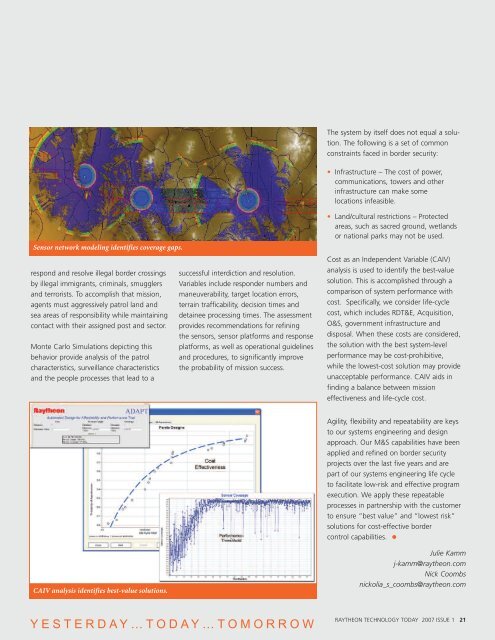Technology Today 2007 Issue 1 - Raytheon
Technology Today 2007 Issue 1 - Raytheon
Technology Today 2007 Issue 1 - Raytheon
Create successful ePaper yourself
Turn your PDF publications into a flip-book with our unique Google optimized e-Paper software.
Sensor network modeling identifies coverage gaps.<br />
respond and resolve illegal border crossings<br />
by illegal immigrants, criminals, smugglers<br />
and terrorists. To accomplish that mission,<br />
agents must aggressively patrol land and<br />
sea areas of responsibility while maintaining<br />
contact with their assigned post and sector.<br />
Monte Carlo Simulations depicting this<br />
behavior provide analysis of the patrol<br />
characteristics, surveillance characteristics<br />
and the people processes that lead to a<br />
CAIV analysis identifies best-value solutions.<br />
successful interdiction and resolution.<br />
Variables include responder numbers and<br />
maneuverability, target location errors,<br />
terrain trafficability, decision times and<br />
detainee processing times. The assessment<br />
provides recommendations for refining<br />
the sensors, sensor platforms and response<br />
platforms, as well as operational guidelines<br />
and procedures, to significantly improve<br />
the probability of mission success.<br />
Y E S T E R D A Y … T O D A Y … T O M O R R O W<br />
The system by itself does not equal a solution.<br />
The following is a set of common<br />
constraints faced in border security:<br />
• Infrastructure – The cost of power,<br />
communications, towers and other<br />
infrastructure can make some<br />
locations infeasible.<br />
• Land/cultural restrictions – Protected<br />
areas, such as sacred ground, wetlands<br />
or national parks may not be used.<br />
Cost as an Independent Variable (CAIV)<br />
analysis is used to identify the best-value<br />
solution. This is accomplished through a<br />
comparison of system performance with<br />
cost. Specifically, we consider life-cycle<br />
cost, which includes RDT&E, Acquisition,<br />
O&S, government infrastructure and<br />
disposal. When these costs are considered,<br />
the solution with the best system-level<br />
performance may be cost-prohibitive,<br />
while the lowest-cost solution may provide<br />
unacceptable performance. CAIV aids in<br />
finding a balance between mission<br />
effectiveness and life-cycle cost.<br />
Agility, flexibility and repeatability are keys<br />
to our systems engineering and design<br />
approach. Our M&S capabilities have been<br />
applied and refined on border security<br />
projects over the last five years and are<br />
part of our systems engineering life cycle<br />
to facilitate low-risk and effective program<br />
execution. We apply these repeatable<br />
processes in partnership with the customer<br />
to ensure “best value” and “lowest risk”<br />
solutions for cost-effective border<br />
control capabilities. •<br />
Julie Kamm<br />
j-kamm@raytheon.com<br />
Nick Coombs<br />
nickolia_s_coombs@raytheon.com<br />
RAYTHEON TECHNOLOGY TODAY <strong>2007</strong> ISSUE 1 21

















